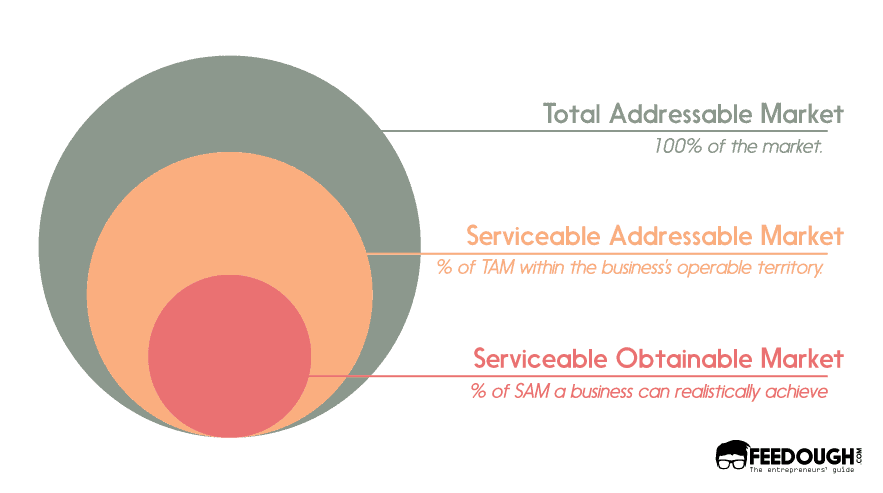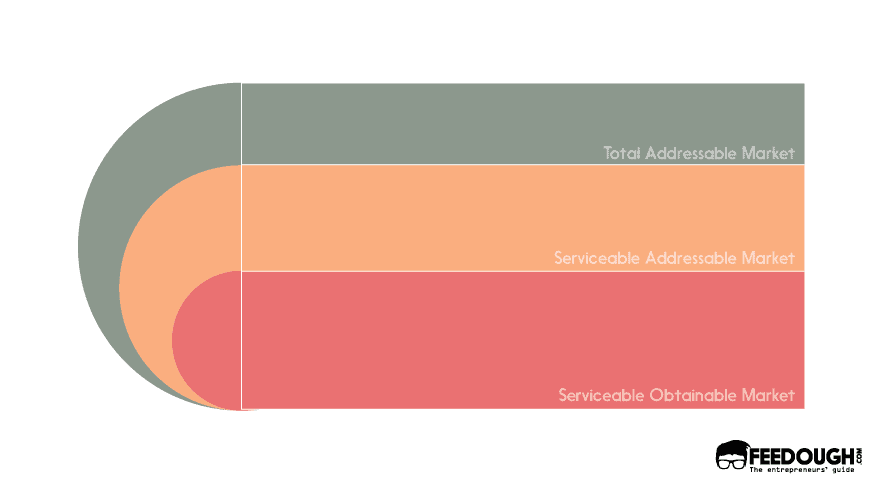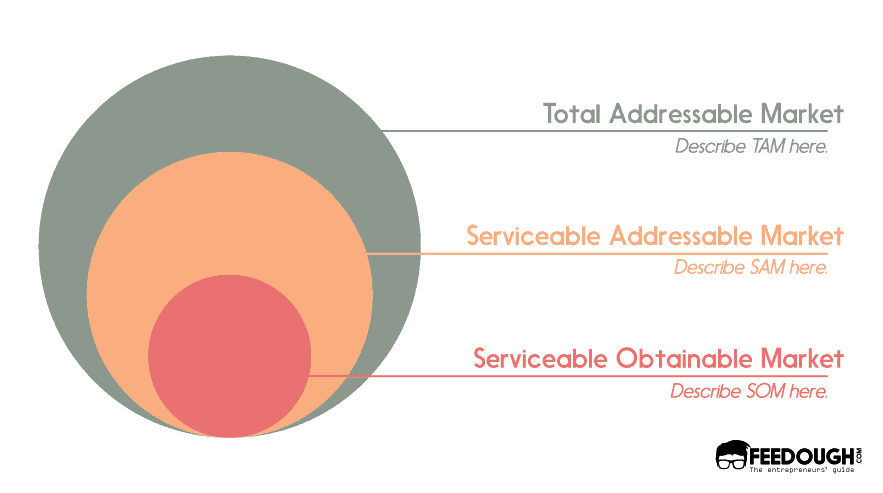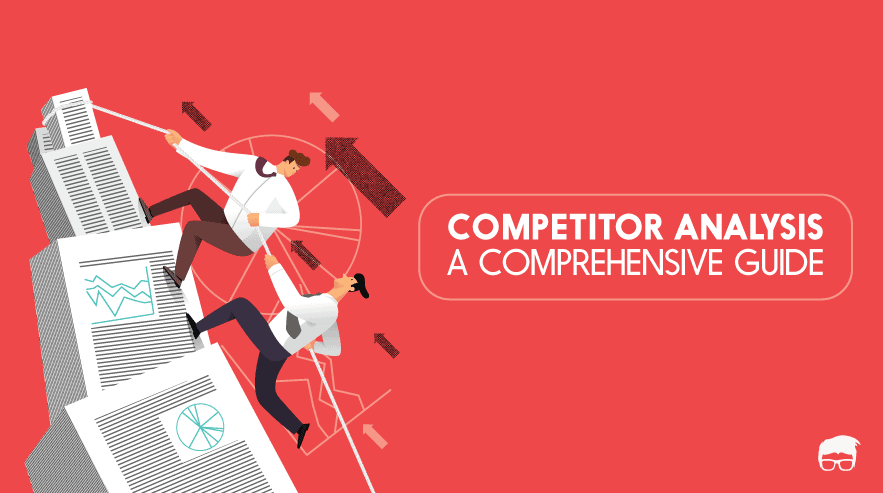Developing a product without proper market analysis is a gamble. Any experienced or skilled marketer will always analyse the market and choose the right target segment before developing the product, marketing it, and developing the pricing and sales strategies.
Those who don’t do this drill may end up in a market –
- Which isn’t right for the offering,
- With not large enough market size to grow, or
- Which is dominated by existing players with no space for new players to penetrate into.
Hence, to ensure that the market is right and big enough for the business, it is crucial to understand what is TAM, SAM, and SOM and how to calculate them.
What Is TAM?
TAM or Total Addressable Market refers to the total market demand or revenue opportunity that exists within the market for the offering.
TAM = 100% of the market.
In simple terms, TAM comprises everyone who could buy the offering or the maximum amount of revenue a business can earn by selling their offering.
TAM is a significant number. It isn’t restrained by constraints other than the offering. It doesn’t consider competition, business limitations, geographic limitations, or any factor that may stop the business from reaching and selling to the market.
For example, for Uber, the total addressable market was the global taxi market.
Why Is Calculating TAM Important?
The total addressable market (also called total available market) helps a business identify how big the opportunity is and how much revenue can be made with the offering if 100% of the market share were achieved.
This helps determine –
- Market’s potential for growth,
- Business concept’s viability, and
- Effort and funding that might be required to operate in the market.
How To Calculate TAM?
While the equation to calculate TAM seem simple…
Average Revenue * Number Of Customers For The Entire Segment Of The Targeted Market
…the actual process of getting these numbers is difficult, tedious, and/or expensive. It includes the following approaches –
- External Research: It involves getting the information from professional data that has already been collected. This approach is expensive but saves a lot of time of the businesses.
- Top-Down Approach: Top-down approach starts from the top of the macro data set and filters the data to find the perfect market subset. That is –starting with the total population and then apply the demographic, geographic, and economic assumptions to eliminate the irrelevant segments. For example – to find the TAM of an Android accounting mobile application, the data of total accounting smartphone app users is taken and then chipped away to remove iOS users. The data is then multiplied by the average cost of an accounting app to get to the TAM.
- Bottom-Up Approach: Being a total opposite of the top-down approach, this approach focuses on building the TAM using the subsets of information available. Suppose a mineral water company that has a 20% share of the total market of the USA had revenue of $1B in a recent year. Using this information, the 100% market of the mineral water company in the USA comes out to be $5 billion.
- Value Theory: Top-down and bottom-up approach try to find the total addressable market of an existing market. However, in cases of startups that disrupt (like flying cars) and develop their own market, the value theory approach kicks in. This approach assesses how much a customer would be willing to pay for an offering or the improvement of a product. This price is then multiplied with the size of the market of the closest possible niche (cars in case of flying cars).
What Is SAM?
SAM or Serviceable Available Market is the portion of the total available market that the business can actually acquire. It is the total sales volume of a particular offering that can be sold by all the vendors within the specific operable territory.
SAM = [the] % of TAM that is within the business’s operable territory.
It takes into account all the factors limiting the reach to the total market, like –
- Geographical restrictions
- Demographic restrictions
- Resources restrictions
- Regulatory restrictions
- Cultural restrictions
- Behavioural restrictions
For Uber, the serviceable available market in the start was limited to the taxi market in the USA and users who used a smartphone.
Why Is Calculating SAM Important?
Serviceable available market (also called serviceable addressable market) is a realistic picture of the market that can actually be tapped after considering the limiting factors that cannot be changed.
For example, if a business manufactures a mobile application that helps parents find their kids, the SAM would not be the total number of smartphone users, it’ll be parents of 5-12-year-old kids, who use Android smartphones running on the latest version (Here we assumed that the application is specific to just Android smartphones).
How To Calculate SAM?
SAM starts with the calculation of TAM. Once TAM is calculated, it is filtered down by adding conditions and equations. Suppose a business plans to launch an offering focused on football players in the USA. Considering that there are 20 million football players in the USA, and the cost of the offering to be $50, the TAM comes out to be $900 million.
However, if the business is focusing just on California (having just 500,000 football players), the SAM would come out to be just 0.05% of TAM, that is $25 million.
What Is SOM?
SOM or Serviceable Obtainable Market is the portion of the serviceable addressable market that can be realistically achieved within the short term.
SOM = [the] % of SAM the business can realistically achieve in short-to-medium term.
In simple terms, SOM, also called Share of Market, is the realistic fraction of the actual customer market that the business can acquire during the first few years of operation. It considers the competitive, financial, niche, and resources-based restrictions while predicting realistic reach during the initial years of operation.
SOM factors in –
- The offering’s limitations
- The targeting limitations
- Marketing plans
- Distribution channels
- Competitive limitations
- Limitations relating to finance and other resources
Why Is Calculating SOM Important?
SOM is of vital importance to both the founders and the investors as it –
- Helps business set realistic short-term and medium-term objectives and goals,
- Helps investors and founders understand the potential of the market, and
- Helps the founders make most of their limited resources initially.
How To Calculate SOM?
SOM represents the realistic value of what can be achieved. To get to this realistic value, the following factors are taken into consideration –
- Market share of competitors
- The value proposition of the offering
- Performance of offering’s pre-releases
Performance of offering’s pre-releases gives a hint to how quickly is the offering able to grab business in the market. This, when compared with other factors, give a value, which, when compared with SAM, gives the value of SOM.
For example, suppose a business ‘XY’ wants to launch a sports products brand and has a SAM of $10M. After some research on the existing players, XY finds out that one player takes the majority of the offline market share because of its well-defined distribution channels. However, it doesn’t operate online, which is an opportunity of $2M divided among 4 players, including XY.
After releasing the MVP, XY calculates that it’ll be able to grab 50% of the online market within 3 years. This makes the SOM of this business be $1M, which is 10% of SAM.
Example Of TAM SAM SOM
TAM is the total number of fishes in the sea.
SAM is the total number of fishes within the casting range of the dock one fishes from.
SOM is the number of fishes one can reasonably catch considering the amount of time, energy, and baits (resources) they can allocate to fishing.

TAM, SAM, and SOM can be easily understood with the example of the initial days of Facebook.
Facebook was launched with a motive to become a one-stop social media channel for everyone who uses the internet. Its TAM were global internet users.
However, during its initial years, the company’s operations were limited to the USA, which formed its SAM.
When the company started, it spent its initial days in attracting college students and other student communities from the universities of the USA, which formed its SOM.
TAM SAM SOM Template
Here’s a TAM SAM SOM template to help businesses present their market analysis better.


Go On, Tell Us What You Think!
Did we miss something? Come on! Tell us what you think about our article on TAM SAM SOM in the comments section.
A startup consultant, digital marketer, traveller, and philomath. Aashish has worked with over 20 startups and successfully helped them ideate, raise money, and succeed. When not working, he can be found hiking, camping, and stargazing.

![Go-To-Market Strategy [The Ultimate Guide] go-to-market strategy](https://www.feedough.com/wp-content/uploads/2019/10/go-to-market-strategy.webp)






